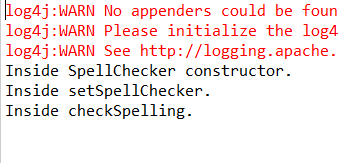Spring(五)之Bean定义继承和依赖注入
一、Bean定义继承
bean定义可以包含许多配置信息,包括构造函数参数,属性值和特定于容器的信息,例如初始化方法,静态工厂方法名称等。
子bean定义从父定义继承配置数据。子定义可以根据需要覆盖某些值或添加其他值。
Spring Bean定义继承与Java类继承无关,但继承概念是相同的。您可以将父bean定义定义为模板,其他子bean可以从父bean继承所需的配置。
使用基于XML的配置元数据时,可以使用parent属性指定子bean定义,并将父bean指定为此属性的值。
演示示例:
(1)编写HelloWorld.java
package com.tutorialspoint;
public class HelloWorld {
private String message1;
private String message2; public void setMessage1(String message){
this.message1 = message;
}
public void setMessage2(String message){
this.message2 = message;
}
public void getMessage1(){
System.out.println("World Message1 : " + message1);
}
public void getMessage2(){
System.out.println("World Message2 : " + message2);
}
}
(2)编写HelloIndea.java
package com.tutorialspoint;
public class HelloIndia {
private String message1;
private String message2;
private String message3;
public void setMessage1(String message){
this.message1 = message;
}
public void setMessage2(String message){
this.message2 = message;
}
public void setMessage3(String message){
this.message3 = message;
}
public void getMessage1(){
System.out.println("India Message1 : " + message1);
}
public void getMessage2(){
System.out.println("India Message2 : " + message2);
}
public void getMessage3(){
System.out.println("India Message3 : " + message3);
}
}
(3)编写MainApp.java
package com.tutorialspoint; import org.springframework.context.ApplicationContext;
import org.springframework.context.support.ClassPathXmlApplicationContext; public class MainApp {
public static void main(String[] args) {
ApplicationContext context = new ClassPathXmlApplicationContext("Beans.xml"); HelloWorld objA = (HelloWorld) context.getBean("helloWorld");
objA.getMessage1();
objA.getMessage2(); HelloIndia objB = (HelloIndia) context.getBean("helloIndia");
objB.getMessage1();
objB.getMessage2();
objB.getMessage3();
}
}
(4)Beans.xml
<?xml version = "1.0" encoding = "UTF-8"?> <beans xmlns = "http://www.springframework.org/schema/beans"
xmlns:xsi = "http://www.w3.org/2001/XMLSchema-instance"
xsi:schemaLocation = "http://www.springframework.org/schema/beans
http://www.springframework.org/schema/beans/spring-beans-4.0.xsd"> <bean id = "helloWorld" class = "com.tutorialspoint.HelloWorld">
<property name = "message1" value = "Hello World!"/>
<property name = "message2" value = "Hello Second World!"/>
</bean> <bean id ="helloIndia" class = "com.tutorialspoint.HelloIndia" parent = "helloWorld">
<property name = "message1" value = "Hello India!"/>
<property name = "message3" value = "Namaste India!"/>
</bean> </beans>
(5)运行MainApp.java中的main方法

二、依赖注入
每个基于Java的应用程序都有一些对象可以协同工作,以呈现最终用户所看到的工作应用程序。在编写复杂的Java应用程序时,应用程序类应尽可能独立于其他Java类,以增加重用这些类的可能性,并在单元测试时独立于其他类测试它们。依赖注入(或称为布线)有助于将这些类粘合在一起,同时保持它们的独立性。
依赖注入常用两种形式:
1.set注入(比较常用)
2.构造函数注入
set注入示例:
(1)编写TextEditor.java
package com.tutorialspoint;
public class TextEditor {
private SpellChecker spellChecker;
// a setter method to inject the dependency.
public void setSpellChecker(SpellChecker spellChecker) {
System.out.println("Inside setSpellChecker." );
this.spellChecker = spellChecker;
}
// a getter method to return spellChecker
public SpellChecker getSpellChecker() {
return spellChecker;
}
public void spellCheck() {
spellChecker.checkSpelling();
}
}
(2)编写SpellChecker.java
package com.tutorialspoint;
public class SpellChecker {
public SpellChecker(){
System.out.println("Inside SpellChecker constructor." );
}
public void checkSpelling(){
System.out.println("Inside checkSpelling." );
}
}
(3)编写Beans.xml
<?xml version = "1.0" encoding = "UTF-8"?> <beans xmlns = "http://www.springframework.org/schema/beans"
xmlns:xsi = "http://www.w3.org/2001/XMLSchema-instance"
xsi:schemaLocation = "http://www.springframework.org/schema/beans
http://www.springframework.org/schema/beans/spring-beans-4.0.xsd"> <!-- Definition for textEditor bean using inner bean -->
<bean id = "textEditor" class = "com.tutorialspoint.TextEditor">
<property name = "spellChecker">
<bean id = "spellChecker" class = "com.tutorialspoint.SpellChecker"/>
</property>
</bean> </beans>
(4)编写MainApp.java
package com.tutorialspoint; import org.springframework.context.ApplicationContext;
import org.springframework.context.support.ClassPathXmlApplicationContext; public class MainApp {
public static void main(String[] args) {
ApplicationContext context = new ClassPathXmlApplicationContext("Beans.xml");
TextEditor te = (TextEditor) context.getBean("textEditor");
te.spellCheck();
}
}
(5)运行MainApp.java中的main方法

2.注入集合
Spring提供四种集合注入方式:
(1)Set;(2)List;(3)Map;(4)Props;
演示示例如下:
(1)编写JavaCollection
package com.tutorialspoint;
import java.util.*; public class JavaCollection {
List addressList;
Set addressSet;
Map addressMap;
Properties addressProp; // a setter method to set List
public void setAddressList(List addressList) {
this.addressList = addressList;
} // prints and returns all the elements of the list.
public List getAddressList() {
System.out.println("List Elements :" + addressList);
return addressList;
} // a setter method to set Set
public void setAddressSet(Set addressSet) {
this.addressSet = addressSet;
} // prints and returns all the elements of the Set.
public Set getAddressSet() {
System.out.println("Set Elements :" + addressSet);
return addressSet;
} // a setter method to set Map
public void setAddressMap(Map addressMap) {
this.addressMap = addressMap;
} // prints and returns all the elements of the Map.
public Map getAddressMap() {
System.out.println("Map Elements :" + addressMap);
return addressMap;
} // a setter method to set Property
public void setAddressProp(Properties addressProp) {
this.addressProp = addressProp;
} // prints and returns all the elements of the Property.
public Properties getAddressProp() {
System.out.println("Property Elements :" + addressProp);
return addressProp;
}
}
(2)编写Beans.xml
<?xml version = "1.0" encoding = "UTF-8"?> <beans xmlns = "http://www.springframework.org/schema/beans"
xmlns:xsi = "http://www.w3.org/2001/XMLSchema-instance"
xsi:schemaLocation = "http://www.springframework.org/schema/beans
http://www.springframework.org/schema/beans/spring-beans-4.0.xsd"> <!-- Definition for javaCollection -->
<bean id = "javaCollection" class = "com.tutorialspoint.JavaCollection"> <!-- results in a setAddressList(java.util.List) call -->
<property name = "addressList">
<list>
<value>INDIA</value>
<value>Pakistan</value>
<value>USA</value>
<value>USA</value>
</list>
</property> <!-- results in a setAddressSet(java.util.Set) call -->
<property name = "addressSet">
<set>
<value>INDIA</value>
<value>Pakistan</value>
<value>USA</value>
<value>USA</value>
</set>
</property> <!-- results in a setAddressMap(java.util.Map) call -->
<property name = "addressMap">
<map>
<entry key = "1" value = "INDIA"/>
<entry key = "2" value = "Pakistan"/>
<entry key = "3" value = "USA"/>
<entry key = "4" value = "USA"/>
</map>
</property> <!-- results in a setAddressProp(java.util.Properties) call -->
<property name = "addressProp">
<props>
<prop key = "one">INDIA</prop>
<prop key = "one">INDIA</prop>
<prop key = "two">Pakistan</prop>
<prop key = "three">USA</prop>
<prop key = "four">USA</prop>
</props>
</property>
</bean> </beans>
(3)编写MainApp.java
package com.tutorialspoint; import org.springframework.context.ApplicationContext;
import org.springframework.context.support.ClassPathXmlApplicationContext; public class MainApp {
public static void main(String[] args) {
ApplicationContext context = new ClassPathXmlApplicationContext("Beans.xml");
JavaCollection jc=(JavaCollection)context.getBean("javaCollection"); jc.getAddressList();
jc.getAddressSet();
jc.getAddressMap();
jc.getAddressProp();
}
}
(4)运行MainApp.java中的main方法
结果如下:

Spring(五)之Bean定义继承和依赖注入的更多相关文章
- spring学习五:Spring Bean 定义继承
Bean 定义继承 bean 定义可以包含很多的配置信息,包括构造函数的参数,属性值,容器的具体信息例如初始化方法,静态工厂方法名,等等. 子 bean 的定义继承父定义的配置数据.子定义可以根据需要 ...
- 品Spring:负责bean定义注册的两个“排头兵”
别看Spring现在玩的这么花,其实它的“筹码”就两个,“容器”和“bean定义”. 只有先把bean定义注册到容器里,后续的一切可能才有可能成为可能. 所以在进阶的路上如果要想走的顺畅些,彻底搞清楚 ...
- Spring IOC源代码具体解释之容器依赖注入
Spring IOC源代码具体解释之容器依赖注入 上一篇博客中介绍了IOC容器的初始化.通过源代码分析大致了解了IOC容器初始化的一些知识.先简单回想下上篇的内容 加载bean定义文件的过程.这个过程 ...
- Spring升级案例之IOC介绍和依赖注入
Spring升级案例之IOC介绍和依赖注入 一.IOC的概念和作用 1.什么是IOC 控制反转(Inversion of Control, IoC)是一种设计思想,在Java中就是将设计好的对象交给容 ...
- Spring-初识Spring框架-IOC控制反转(DI依赖注入)
---恢复内容开始--- IOC :控制反转 (DI:依赖注入)使用ioc模式开发 实体类必须有无参构造方法1.搭建Spring环境下载jarhttp://maven.springframework. ...
- 三大框架 之 Spring(IOC控制反转、DI依赖注入)
目录 常用词汇 left join与left outer join的区别 Struts2的标签库导入 Spring Spring概述 什么是Spring spring特点 下载 IOC 什么IOC 传 ...
- spring接口多实现类,该依赖注入哪一个?
一.问题的描述 在实际的系统应用开发中我经常会遇到这样的一类需求,相信大家在工作中也会经常遇到: 同一个系统在多个省份部署. 一个业务在北京是一种实现方式,是基于北京用户的需求. 同样的业务在上海是另 ...
- Spring详解(三)------DI依赖注入
上一篇博客我们主要讲解了IOC控制反转,也就是说IOC 让程序员不在关注怎么去创建对象,而是关注与对象创建之后的操作,把对象的创建.初始化.销毁等工作交给spring容器来做.那么创建对象的时候,有可 ...
- Java框架spring 学习笔记(五):Bean定义继承
子 bean 的定义继承父定义的配置数据.子定义可以根据需要重写一些值,或者添加其他值. 编写HelloWorld.java package com.example.spring; public cl ...
随机推荐
- 用户登录注册(安全)(常规、FB、google、paypal) 实战
/* 用户登录界面 */elseif ($action == 'login'){ if($_SESSION['user_id']) { ecs_header("Lo ...
- csu 1356 Catch bfs(vector)
1356: Catch Time Limit: 2 Sec Memory Limit: 128 MBSubmit: 96 Solved: 40[Submit][Status][Web Board] ...
- eml文件解析实例,简历信息抓取工具
先上工具效果图,如下图所示: 背景 某公司使用58同城进行人员招聘,当有应聘人员通过58同城给该公司投简历后,58同城会发送一份邮件到该公司的注册邮箱,邮件内容如上图右侧显示,主题为“应聘贵公司XXX ...
- 由上一个血案引发的关于property和attribute关系的思考
boss说,学习要刨根问底. 好的,开刨. 一.property和attribute在英语里有什么区别 看似没有区别.但其实大神说: property是 物体本身自带属性,不能改变的(一旦改了就是另外 ...
- Zookeeper + Guava loading cache 实现分布式缓存
1. 概述 项目中,创建的活动内容存入redis,然后需要用到活动内容的地方,从redis去取,然后参与计算. 活动数据的一个特点是更新不频繁.数据量不大.因为项目部署一般是多机器.多实例,除了red ...
- BZOJ1031 [JSOI2007]字符加密
Description 喜欢钻研问题的JS同学,最近又迷上了对加密方法的思考.一天,他突然想出了一种他认为是终极的加密办法 :把需要加密的信息排成一圈,显然,它们有很多种不同的读法.例如下图,可以读作 ...
- 【疑难杂症01】TypeError: alert is not a function
一.背景 话说今天在调试js的时候,碰到一个很奇怪的问题,现记录一下.当使用alert()函数弹出提示时,总是报错,你没看错,alert函数报错了. 二.详细说明 当时正在做一个关于告警的页面展示功能 ...
- postman具体讲解
postman 简单教程-实现简单的接口测试 最近开始做接口测试了,因为公司电脑刚好有postman,于是就用postman来做接口测试,哈哈哈哈,...postman 功能蛮强大的,还比较好用,下面 ...
- gitlab一次代码回滚引起的bug...
问题描述:线上问题有一个bug,挺严重的.在线下排查后发现是一个之前的同事添加的代码影响的,为了不影响之前的业务,代码回滚了. 但是 过了几天,测人人员测试之后说这个问题又复现了,然后再次看,发现还是 ...
- 微信分享BUG
WXFileObject fileObject = new WXFileObject(); fileObject.setContentLengthLimit(1024 * 1024 * 10); fi ...
